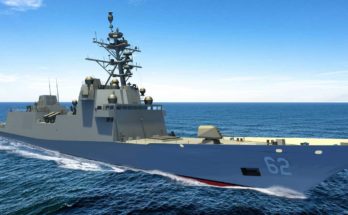By Carter Palmer and Shaun McDougall
Over the next five years, the U.S. Space Force plans to spend $100 billion on acquisition programs. Procurement only accounts for 23.1 percent of that total, while the majority of the U.S. Space Force’s acquisition budget is dedicated to research, development, test, and evaluation (RDT&E) appropriations. Between FY23 and FY27, 76.9 percent of total acquisition spending is going directly to RDT&E.

How is that RDT&E funding being spent?
Throughout the Future Years Defense Program (FYDP), there is a notable increase in missile tracking and satellite communications funding. Using Forecast International’s U.S. Defense Budget Forecast, Forecast International analysts identified the top five line items based on projected spending over the next five years. (These figures are not all-inclusive, as other line items might contribute to these programs as well.)
- Next Generation OPIR
The Next Generation OPIR program is a follow-on to the current SBIRS High, which is an advanced early warning missile identification satellite system that replaced Defense Support Program (DSP) satellites. In order to replace its current generation SBIRS satellites, the Air Force began investigating follow-on systems in 2014. In August 2018, a $2.9 billion contract was awarded to Lockheed Martin to build the Geosynchronous Orbit (GEO) OPIR satellites. In May 2020, Northrop Grumman was awarded $2.36 billion for the Polar-orbiting portion of the constellation. The planned constellation will consist of five satellites: three in GEO and two in Polar orbits. The first GEO satellite is planned for completion in 2025, and the first Polar satellite is planned for completion in 2027. These satellites are known as Block 0. Another series of satellites is planned for the future under Block 1, with deliveries beginning in 2030.
- Space Technology Development and Prototyping
This line supports the SDA’s LEO Tranche 1 transport layer, which is another component of the Next Generation OPIR constellation. Not much information has been provided, but when completed, the layer will move data around the world to where it is needed. Tranche 0 will consist of 20 satellites built by Lockheed Martin and York Space, and these birds will launch in 2022.
- Evolved Strategic SATCOM (ESS)
The Air Force has begun to investigate a follow-on to its AEHF constellation, sometimes referred to as Evolved AEHF and now Evolved Strategic SATCOM (ESS). The service began initial planning and risk reduction efforts in 2017. Three manufacturers — Lockheed Martin, Boeing, and Northrop Grumman — have been awarded contracts for prototype ESS payloads. It is unclear who will manufacture the actual satellites, but these birds should be in orbit in the late 2020s.
- Resilient Missile Warning/Missile Tracking – Low Earth Orbit (LEO)
This line supports the SDA’s tracking layer, which will be part of the OPIR constellation. In October 2020, L3Harris and SpaceX were awarded contracts for four satellites each to begin development of the Tracking Layer Tranche 0. The eight satellites are presumably completed and will launch in 2022-23 on Falcon 9 rockets. The second generation of satellites, known as Tranche 1, will consist of 28 birds and launch in the 2024–2025 timeframe. The contractors for the Tranche 1 satellites, L3Harris and Northrop Grumman, were awarded contracts for up to a combined $1.3 billion. Each company will build 14 satellites and will launch starting in 2025.
- Space Science and Technology Research and Development
This line supports the SDA’s multi-layer satellite constellation, with particular emphasis on the transport layer. The total FYDP projection for this line item is $2,769,608.

Why the uptick in RDT&E funding?
The Space Development Agency (SDA), established in 2019, was formally integrated into the Space Force on October 1, 2022. That change had a notable impact on the service’s RDT&E budget, as three of the top five line items are related to the SDA’s multi-layer satellite constellation, including transport and tracking satellite layers.
How will these programs impact the upcoming year?
The top five RDT&E programs are valued at a combined $6 billion in FY23 and a total of $31.1 billion over the FYDP. Over the FYDP, these five line items represent 40 percent of the Space Force’s entire research and development budget and around 31 percent of all acquisition funding for the fledgling service.
Stay ahead of any defense budget changes — Space Force or otherwise.
Forecast International’s U.S. Defense Budget Forecast makes it easy to navigate the latest U.S. defense budget. The product features sorting and data visualization options and presents the entire FYDP through an online interface with downloadable Excel spreadsheets. This is the go-to service for anyone looking to save time and energy in navigating the massive DoD budget.
For 50 years, Forecast International intelligence reports have been the aerospace and defense industry standard for accurate research, analysis, and projections. Our experienced analysts compile, evaluate, and present accurate data for decision makers. FI's market research reports offer concise analysis of individual programs and identify market opportunities. Each report includes a program overview, detailed statistics, recent developments and a competitive analysis, culminating in production forecasts spanning 10 or 15 years. Let our market intelligence reports be a key part of reducing uncertainties and mastering your specific market and its growth potential. Find out more at www.forecastinternational.com



